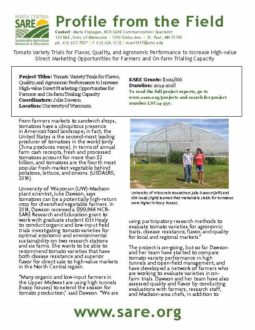From farmers markets to sandwich shops, tomatoes have a ubiquitous presence in America’s food landscape; in fact, the United States is the second-most leading producer of tomatoes in the world (only China produces more). In terms of annual farm cash receipts, fresh and processed tomatoes account for more than $2 billion, and tomatoes are the fourth most popular fresh-market vegetable behind potatoes, lettuce, and onions. (USDA-ERS, 2016).
University of Wisconsin (UW)-Madison plant scientist, Julie Dawson, says tomatoes can be a potentially high-return crop for diversified vegetable farmers. In 2014, Dawson received a $199,866 NCR-SARE Research and Education grant to work with graduate student Kitt Healy to conduct organic and low-input field trials investigating tomato varieties for optimal economic and environmental sustainability on two research stations and six farms. She wants to be able to recommend tomato varieties that have both disease resistance and superior flavor for direct sale to high-value markets in the North Central region.
“Many organic and low-input farmers in the Upper Midwest are using high tunnels (hoop houses) to extend the season for tomato production,” said Dawson. “We are using participatory research methods to evaluate tomato varieties for agronomic traits, disease resistance, flavor, and quality for local and regional markets.”
The project is on-going, but so far Dawson and her team have started to compare tomato variety performance in high tunnels and open-field management, and have developed a network of farmers who are working to evaluate varieties in on-farm trials. Dawson and her team have also assessed quality and flavor by conducting evaluations with farmers, research staff, and Madison-area chefs, in several public taste tests at field days and other events.
According to Healy, in the 2014 preliminary trials, marketable yield was 20% greater in the hoop house, and in 2015, marketable yield was 45% higher in the hoop house. This difference is most likely due to both an extended season and substantially lower foliar disease incidence in the high tunnel environment.
Dawson says that in addition to their findings on tomato variety performance, they adapted their participatory trialing methodology to more meaningfully involve farmers and other experts in variety trialing research.
“We now have an increasing number of farmers interested in conducting on-farm variety trials and an increasing number of plant breeders working on organic and low input systems wanting to trial their varieties in the upper Midwest with our network,” said Dawson.
View Kitt Healy's presentation on this project, from the 2017 Farmers Forum, through NCR-SARE's YouTube playlist. Visit www.youtube.com/NCRSAREvideo for this and other videos.
